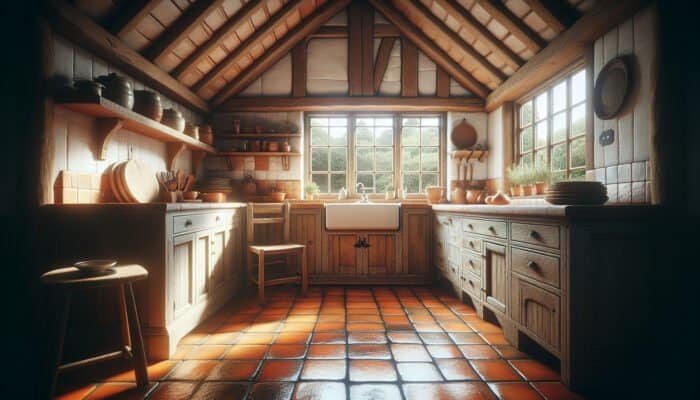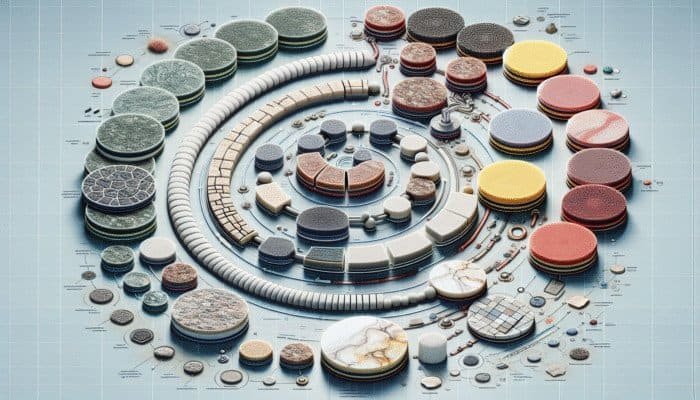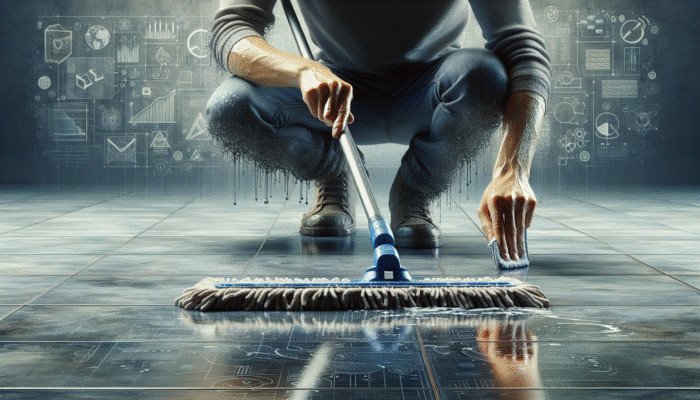


June 20, 2025 by
David Allen

Achieving a flawless finish on your stone floors hinges significantly on the selection of polishing pads. Various pad types exist, each tailored for specific materials and tasks. The most frequently used include diamond polishing pads, resin pads, and various lesser-known options. Diamond pads are celebrated for their durability and efficiency, which makes them ideal for robust stones like granite and concrete. These pads are constructed with diamond segments embedded in a flexible backing, allowing for grinding and polishing without compromising quality.
In contrast, resin pads are typically employed for softer stones, such as marble and limestone, providing a finer finish while less aggressive than their diamond counterparts. The versatility of polishing pads ensures that, irrespective of the stone type, an appropriate pad is available. Additionally, hybrid pads that combine the attributes of both diamond and resin pads offer a balanced solution for those seeking effective results across diverse stone varieties. Gaining insight into the unique characteristics of each pad type empowers homeowners to make informed decisions that elevate the aesthetic appeal of their stone floors.
The grit level of polishing pads is crucial to the overall polishing process. Grit levels vary widely, ranging from coarse (approximately 30-50) to ultra-fine (up to 3000 or greater). Coarse grit pads are particularly effective during the initial grinding phase, focusing on removing imperfections, scratches, and previous finishes. As the process advances, finer grit pads are utilised to achieve a smoother surface and a high-gloss finish that enhances the stone’s natural beauty.
Comprehending the grit levels and their respective applications is vital for anyone aiming to polish their stone floors effectively. For example, transitioning from a coarse pad to a medium pad (around 100-200 grit) is critical in preparing the surface before applying finer pads. Each stage in the grit sequence is essential; bypassing levels can lead to uneven surfaces or insufficient polishing outcomes. Therefore, it is imperative to adhere to the correct progression of grit levels to attain a professional-grade finish that genuinely reflects the quality of your stone flooring.
Selecting the correct polishing pad is not merely a matter of personal preference; it is fundamental to your stone floor’s durability and visual appeal. Different stones necessitate distinct approaches. For instance, harder stones like granite require diamond pads to achieve effective polishing, while softer stones such as marble benefit from resin-based pads that mitigate unnecessary wear and tear.
Additionally, assessing the condition of the floor is equally crucial. If your stone floor exhibits significant scratches or damage, commencing with a coarse pad is essential before progressing to finer options. Furthermore, the size of the area to be polished can affect your pad selection; larger spaces may necessitate pads that cover more surface area efficiently, while intricate areas might require smaller, more precise pads. By carefully considering these factors, you can ensure optimal polishing results explicitly tailored to your stone type and floor condition.

Diligent maintenance is essential to extend the lifespan and enhance the performance of your polishing pads. After each use, it is imperative to clean the pads thoroughly to eliminate any dust, debris, or residue that may have accumulated during the polishing process. Employing water and a gentle brush can effectively dislodge particles without causing damage to the pad material.
Proper storage is essential; pads should be kept in a calm, dry environment to prevent degradation. Avoid stacking pads directly on each other, which can lead to deformation. Instead, store them in a manner that maintains their shape, such as in a designated storage container or by hanging them. Regular maintenance not only prolongs the life of your polishing pads but also enhances their efficiency, ensuring that your stone floors receive the best possible finish with every use.
A combination of technique and equipment knowledge is essential to effectively use polishing pads. It’s vital to start with the correct amount of water, which lubricates the pad and minimises friction. This not only protects the stone surface but also prolongs the lifespan of the pad itself, making the polishing process more efficient.
Applying even pressure across the pad is crucial; uneven pressure can result in inconsistent finishes, with specific areas appearing dull while others shine brightly. It is advisable to work in small sections, gradually overlapping each pass to ensure that all areas receive adequate attention. Furthermore, adjusting your speed and movement technique can significantly influence the polishing outcome; slower, steady movements often yield superior results to fast, erratic ones. By mastering these techniques, you can achieve a polished stone floor that enhances the beauty and elegance of your space.

Before commencing the polishing process, ensuring that your stone floor is meticulously cleaned is paramount. Dust, dirt, and grime can interfere with polishing and result in unsatisfactory outcomes. Begin by sweeping or vacuuming the floor to remove loose debris. Following this, a deep clean using a pH-neutral cleaner specifically formulated for stone surfaces is highly recommended.
Mix the cleaner according to the manufacturer’s instructions and apply a mop or cloth evenly across the surface. It is critical to avoid using acidic or abrasive cleaners, as these can cause irreversible damage to the stone. After cleaning, rinsing the floor with clean water will assist in removing any residual cleaning solution. Allow the floor to dry completely before proceeding to the following stage of the polishing process. This thorough cleaning prepares the stone for polishing and uncovers any hidden imperfections that may need addressing before beginning.
Addressing any damages, such as chips or cracks, in your stone floor before polishing is essential for achieving a high-quality finish. Minor cracks can often be repaired using epoxy or resin fillers specifically designed for stone. These products blend seamlessly with the stone’s natural colour and can be sanded after curing to create a smooth surface.
For more substantial damage, consulting a professional may be advisable. They can assess the situation and recommend the best course of action, whether it involves additional repairs or a complete stone resurfacing. Neglecting these damages before polishing could make them more pronounced post-process, leading to a less desirable finish. Investing time in effectively repairing these issues will help ensure that your polishing efforts yield spectacular results that enhance the overall appearance of your stone flooring.
It is of utmost importance to prioritise safety during the preparation of your stone floors for polishing. The use of polishing equipment can generate dust and create slip hazards. Therefore, wearing appropriate personal protective equipment (PPE) is essential. This includes goggles to protect your eyes from dust and debris, a mask or respirator to prevent the inhalation of fine particles, and gloves to safeguard your skin.
Ensure your workspace is well-ventilated, particularly if you use chemical cleaners or sealants. Additionally, be mindful of your surroundings—clear away any obstacles that could present tripping hazards. If you are using electrical machinery, verify it is in good working condition and adhere to all manufacturer instructions to prevent accidents. By implementing these safety measures, you can create a safer working environment, allowing you to concentrate on achieving the best possible results for your stone floor.
The initial grinding process is critical in preparing your stone floor for polishing. This phase removes old finishes and addresses scratches or imperfections by employing coarse polishing pads, typically with a grit level between 30 and 50. It is advisable to start with a dry method for this step, as it allows for better control and easier debris removal.
Begin in a corner of the room and work across the floor in overlapping sections. Keeping the floor surface moist can help minimise dust and enhance the performance of the pads. Always ensure the pads are in optimal condition and replace them as they wear down to maintain their effectiveness. Following the initial grinding, a thorough floor cleaning is necessary to eliminate the dust generated by this process, setting the stage for the subsequent polishing steps.
Intermediate polishing is where the transformation of your stone floor truly begins to take shape. Moving to medium grit pads (around 100 to 200), the focus shifts to further smoothing the surface. This stage is essential for eliminating scratches from the initial grinding and preparing the stone for a finer finish.
Maintaining a damp floor during this phase is beneficial, as it helps to reduce friction and prevent the pads from overheating. As you work, it is crucial to apply consistent pressure while maintaining a steady, overlapping pattern. The duration spent on each section will vary depending on the stone’s condition, but the goal should be to achieve a uniform surface with a noticeable sheen. Regularly inspect your progress and adjust your technique to ensure an even finish across the floor.
Reaching the final buffing stage is an exhilarating milestone in your stone floor polishing journey. This phase utilises fine grit pads (ranging from 800 to 3000) to bring out the highest shine possible. The key to successful buffing lies in maintaining a clean, moist surface, which not only enhances the pad’s effect but also prevents dust from compromising the finish.
As you buff, employ slow, controlled movements, allowing the pad to work its magic over the surface. Switching between different grit levels may be advantageous to achieve a more pronounced shine. After buffing, conducting a final inspection of the floor is advisable. Check for any areas requiring additional attention or touch-ups, ensuring your stone floor achieves that immaculate finish you have been striving for.
Conducting a thorough surface inspection after polishing is critical to ensure your stone floor is flawless and ready for sealing. Look for imperfections, such as uneven patches, scratches, or areas that did not receive adequate polishing. If any issues are detected, addressing them before proceeding with the sealing process is essential.
Utilising a bright light can help highlight any remaining imperfections that may not be visible under normal lighting conditions. If you identify areas that require additional polishing, mark them for further attention. This meticulous inspection ensures that your stone floor looks beautiful and is prepared for the protective sealing that will follow, safeguarding your efforts and maintaining the floor’s exquisite appearance for years to come.
Applying a protective sealant to your stone floor post-polishing is crucial for maintaining its shine and longevity. Sealants are a barrier against stains, moisture, and dirt, ensuring your polished floor remains pristine. Selecting the proper sealant depends on the type of stone you possess, as different stones necessitate different formulations.
Before applying the sealant, ensure the floor is immaculate and dry. Follow the manufacturer’s instructions for application, which typically involves using a clean cloth or applicator to spread the sealant evenly across the surface. Allowing the adhesive to cure properly is essential, as this will enhance its effectiveness. Regular resealing, typically every one to three years depending on usage, will help maintain the stunning appearance of your stone floor and protect it against daily wear and tear.
Maintaining the shine of your polished stone floors necessitates a consistent cleaning routine. Daily cleaning using a soft broom or vacuum removes loose dirt and debris that could scratch the surface. For deeper cleaning, employ a pH-neutral cleaner formulated for stone, applied with a damp mop or cloth.
Avoid harsh chemicals and abrasive tools, which can dull the finish and damage the stone. Weekly cleaning can incorporate a more thorough wash with a suitable stone cleaner, effectively removing buildup. Furthermore, consider placing mats at entry points to reduce the amount of dirt and debris tracked onto your polished floors. By adhering to this regular cleaning routine, you can preserve the beauty and integrity of your stone floors for years to come.
Preventing damage to your polished stone floors involves proactive measures that protect them from wear and tear. One of the most effective strategies is to utilise furniture pads under the legs of tables and chairs, preventing scratches when moving items.
Additionally, avoid dragging heavy items across the floor, which can result in significant scratches and gouges. Be vigilant with spills; promptly cleaning up any liquids will prevent staining and etching on the surface. Consider using runners or area rugs to protect the stone in high-traffic areas. By implementing these preventative strategies, you can maintain the stunning appearance of your polished stone floors for the long term.
Periodically assessing and maintaining your polished stone floors is vital to keep them looking their best. Depending on foot traffic and usage, a deep clean and re-polishing may be required every one to three years. This process includes a thorough cleaning followed by polishing with appropriate pads to restore shine and address any minor scratches or imperfections that may have developed over time.
In addition to re-polishing, consider periodic sealing to safeguard your floors from stains and moisture. Regular checks for signs of wear, such as loss of shine or visible scratches, will help you determine when maintenance is necessary. By committing to a schedule of periodic maintenance, you can ensure the longevity and beauty of your polished stone floors remain intact.
Choosing the proper cleaning and maintenance products is critical to maintaining your polished stone floors. A pH-neutral cleaner designed for stone is ideal for daily cleaning, as it won’t harm the finish or the stone itself. Avoid acidic or abrasive products that can dull the surface or cause etching.
For sealing, look for high-quality sealants compatible with your specific type of stone. Many sealants are available in penetrating and topical formulas, each providing different levels of protection. It’s advisable to consult with a local supplier or stone care expert to ensure that you choose products that suit your specific flooring needs. Investing in the right products can significantly enhance the appearance and durability of your polished stone floors.
Addressing stains and spills promptly is essential in preserving the integrity of your polished stone floors. As soon as a spill occurs, blot it with a clean, dry cloth instead of rubbing it, as this can spread the liquid and worsen the stain. For stubborn stains, using a poultice can be effective; this involves applying a paste made from a suitable cleaning agent to the stained area and allowing it to sit for several hours to extract the stain.
After treating stains, it is essential to follow up with a gentle clean using a pH-neutral stone cleaner. For more serious or persistent stains, professional cleaning services may be necessary. You can ensure that your polished stone floors stay beautiful and unblemished for years by remaining vigilant and responsive to spills and stains.
Experiencing uneven polishing outcomes can be frustrating; understanding the causes and solutions can help rectify the situation. One prevalent reason for uneven finishes is the inconsistent pressure applied during polishing. It is crucial to apply even pressure across the pad while working, ensuring that all areas receive uniform treatment.
If you notice uneven polishing, retrace your steps using finer grit pads to blend the affected areas with the surrounding surface. Additionally, ensure that your polishing pads are in optimal condition; worn-out pads can lead to inconsistent results. Finally, consider the technique and speed you employed; adjusting these factors can significantly improve the uniformity of the finish. You can achieve a polished stone floor that radiates uniformity and elegance by carefully addressing these elements.
Stains and etching can occur even after a comprehensive polishing process, and it is crucial to address them promptly. Stone floors, notably softer varieties like marble, are susceptible to etching from acidic substances such as citrus or vinegar. If etching occurs, it may necessitate specialised polishing techniques or products designed to restore the surface.
For stains, employing a poultice, as previously mentioned, can assist in lifting discolouration. Alternatively, specific stain removal kits designed for stone can be beneficial, depending on the nature of the stain. Regularly sealing your floors also aids in preventing staining and etching over time. By being proactive and employing effective solutions, you can keep your polished stone floors looking pristine and well-maintained.
Effectively managing and extending the life of your polishing pads is essential for maintaining efficiency and achieving quality results. Regularly inspect your pads for signs of wear, such as fraying or loss of abrasiveness. Rotating pads frequently during polishing can also help distribute wear evenly and prolong their lifespan.
Proper cleaning and storage are crucial; ensure pads are thoroughly cleaned after each use and stored in a manner that prevents damage. Avoid exposing them to extreme heat or moisture, which can degrade the materials. By adhering to these practices, you can maximise the longevity of your polishing pads, ensuring they remain practical tools in your stone maintenance arsenal.
There are specific circumstances when enlisting professional services for stone floor polishing becomes necessary. If your stone floor has substantial damage, such as deep scratches, large cracks, or uneven surfaces, a professional can provide the expertise and equipment to restore it effectively.
Furthermore, if you find the polishing process overwhelming or excessively labour-intensive, seeking professional assistance can save time and guarantee quality results. Professionals possess advanced knowledge of different stone types and the appropriate techniques to employ, which can enhance the overall finish. Recognising when to seek professional help can significantly improve the outcome of your stone floor maintenance efforts.
Choosing the right service provider for stone floor polishing involves several critical considerations. Start by researching local companies with positive reviews and testimonials. Look for providers specialising in stone floor care with a proven track record of successfully servicing similar types of stone.
Inquire about their process, including the products and techniques they employ, to ensure they align with your needs and preferences. Additionally, request information about warranties or guarantees for their work, which can provide peace of mind. By conducting thorough research and selecting a reputable provider, you can ensure that your stone floors receive the best care possible.
When you hire professionals for stone floor polishing, understanding the process can help manage expectations. Initially, the service provider will assess your floor’s condition and determine the required methods and products. Following this, they will carry out the polishing process, which may include grinding, polishing, and sealing, depending on the floor’s specific needs.
Professionals will also communicate clearly with you throughout the process, ensuring that you are informed of the various stages involved. Upon completion, you can expect a visibly improved stone floor featuring a high-gloss finish that enhances the beauty of your space. Being informed about what to expect will help you appreciate the value of professional services for your stone flooring.
Estimating costs for professional stone floor polishing services can vary widely based on several factors, including the size of the area, the condition of the stone, and the specific services required. Generally, prices can range from £5 to £10 per square foot, though this can fluctuate based on the job’s complexity and the service provider’s expertise.
It’s advisable to obtain multiple quotes from different companies to compare pricing and services. Remember that while budget considerations are important, quality should not be compromised; finding a balance between reasonable pricing and reputable service is crucial. Understanding the potential costs involved will help you plan effectively and ensure that your stone floors receive the professional attention they deserve.
After investing in professional stone floor polishing, maintaining the results is essential for longevity. Implementing a regular cleaning routine with pH-neutral products helps preserve the shine and protect the surface from stains and damage.
Consider scheduling periodic professional maintenance to ensure your floors remain in top condition. Additionally, preventative measures, such as using mats at entry points and placing furniture pads under heavy items, will safeguard your investment. By committing to these practices, you can enjoy the stunning results of your professionally polished stone floors for years.
Stone floor polishing pads are specialised tools designed to smooth and shine stone surfaces through various grit levels, ensuring a polished finish that enhances the stone’s appearance.
Polishing frequency depends on usage; generally, it is advisable to polish every one to three years, or more often in high-traffic areas, to maintain the floor’s appearance.
No, it is essential to avoid using acidic or abrasive cleaners. Instead, opt for pH-neutral products specifically formulated for stone to prevent any potential damage.
For stains, it is best to blot immediately and consider using a poultice or a stone-specific stain removal kit ty lift discolouration without damaging the surface.
If your stone floor exhibits significant scratches, unevenness, or persistent stains that you cannot address, it may be time to seek professional assistance for optimal restoration.
Seek providers with positive reviews, expertise in stone care, and transparency about their methods and products used to ensure quality service.
Different stones require specific pads; diamond pads are more suitable for harder stones, while resin pads are designed for softer varieties.
To protect your polished surfaces from potential damage, use furniture pads, refrain from dragging heavy items, and promptly clean up spills.
Sealing creates a protective barrier against stains and moisture, helping to maintain the stone’s shine and longevity, ensuring it remains beautiful for years.
Yes, DIY polishing is achievable with the appropriate tools and knowledge; however, professional services may provide superior results in certain instances.